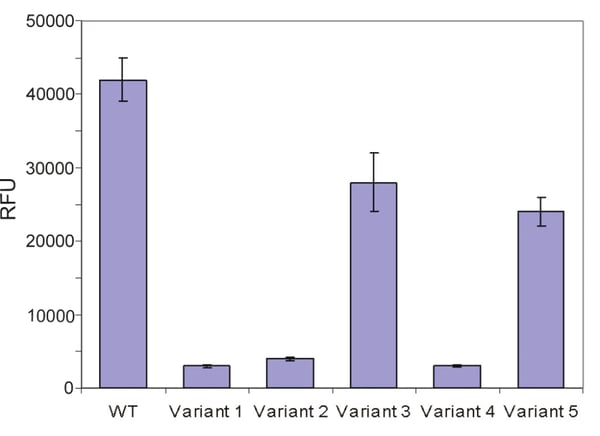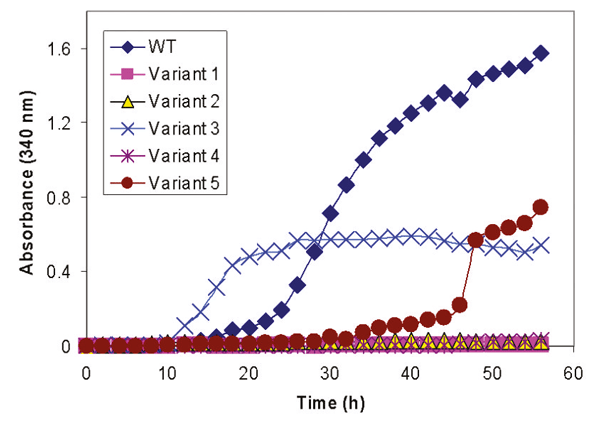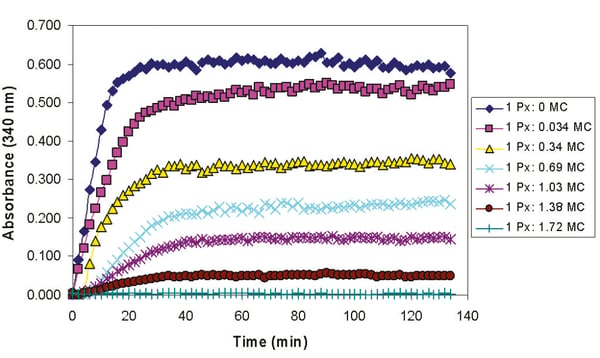Summary
Protein aggregation is the cause of many debilitating and often incurable human diseases. Moreover, aggregation during drug formulation invariably leads to reduced efficacy, low yield, poor storage capacity, and increased production costs. Two assays were applied on a BMG LABTECH microplate reader to assess protein aggregation. One is based on the increase in fluorescence intensity of Thioflavin T (ThT) when binding β-sheet-rich fibrils; the other is based on turbidity changes induced by precipitated protein.
Using a BMG LABTECH multi-mode microplate reader, differences in aggregation of wildtype and mutated protein were determined by heating the samples up to 60 °C and monitoring absorbance at 340 nm. These differences were confirmed using a ThT end point assay. High fluorescence was observed for the wild-type self-aggregating protein whereas some mutated forms gave low fluorescence signals.
We demonstrated that the BMG LABTECH microplate reader is well-suited to screen for aggregation properties in medium to high throughput as well as to follow the kinetics of protein aggregation.
Introduction
Protein aggregation is the underlying cause of many debilitating and often incurable human diseases. Moreover, aggregation during drug formulation invariably leads to reduced efficacy, low yield, poor storage capacity, and increased production costs.
The ability to understand why and how proteins aggregate will undoubtedly help improve upon current strategies aimed at eliminating the causes and effects of this phenomenon. This may sound easy but the reality is that, the conditions required to induce protein aggregation are often highly protein-specific and are as varied as the proteins themselves.
The task of assessing what effect temperature, pH, molecular crowding, sequence mutations, etc. have on the aggregation of a given protein would be almost impossible if not for the availability of firmly established screening techniques.
In this report, we explore some of the features of the BMG LABTECH microplate readers by highlighting examples of their potential uses in the study of protein aggregation.
The results presented here were obtained from recent aggregation studies of a protein which, due to its inherent propensity to self-aggregate to form fibrils, has severely diminished therapeutic potentials. Due to the sensitive nature of this study, it shall be referred in this report simply as “Protein X”.
Materials & Methods
1. Assessment of protein aggregation by absorbance and fluorescence
Since the wild-type form of “Protein X” was inherently susceptible to aggregation, we designed a number of variants containing minimal residue substitution. Using the BMG LABTECH microplate reader, we proceeded to test their ability to aggregate in a hope of finding a suitable substitute for the therapeutically valued WT sequence. The time-dependent aggregation by “Protein X” and variants were followed by measuring the turbidity associated with the formation of precipitated protein at A340. The end-point formation of fibrous aggregates was assessed by measuring the fluorescence associated with the specific binding of the dye, Thioflavin T (Th-T), to the ß-sheet-rich fibrils.
Procedure:
i) Prepare “Protein X” at a protein concentration of 1mg/mL
ii) Add 100 mL aliquots to separate wells of a 96- or 384-well microplate, depending on how many tests are required.
iii) Insert the plate into the BMG LABTECH microplate reader and adjust the instrument settings as shown:
For absorbance
| Wavelength: | 340 nm |
| Meas. start time: | 0 s |
| Cycle time | 7200 s |
| Number of cycles: 30 | 30 |
| Shaking time*: | 300 s |
| Shaking: | orbital |
| Temperature: |
37°C |
For fluorescence
| Ex. filter wavelength: |
440 nm |
| Em. filter wavelength: | 480 nm |
| Temperature: | 25°C |
iv) Start program
* Shaking the samples will help promote protein aggregation and lessen the time for this event to occur.
2. Assessment of the dose-dependent inhibition of temperature-induced protein aggregation by molecular chaperones
Molecular chaperones are proteins that possess the unique ability to stabilise and prevent the aggregation of partially unfolded proteins. Here, we illustrate how a BMG LABTECH microplate reader can be used to assess the suppressive effects of molecular chaperones on the aggregation of “Protein X”. As “Protein X” is heat labile, we have chosen to take advantage of the heating capabilities of the microplate reader by subjecting the protein to 60°C, in the presence or absence of the chaperone of our choice.
Procedure:
i) Prepare solutions of “Protein X” alone, chaperone alone, or “Protein X” with different concentrations of chaperone and then add them into separate wells of a microplate.
ii) Insert the plate into the pre-heated (60°C) BMG LABTECH microplate reader and adjust the instrument settings as shown:
|
Wavelength: |
340 nm |
| Meas. start time: | 0 s |
| Cycle time: | 120 s |
| Number of cycles: | 70 |
| Shaking time: | 60 s |
| Shaking: | orbital |
| Temperature: | 60°C |
iii) Run time course
Results & Discussion
Figure 1 shows the plot of protein aggregation by wild- type “Protein X” and its variants. Out of the 6 proteins tested 3 did not exhibit any detectable tendencies to self-aggregate.
Thioflavin T binding studies showed high fluorescence associated with the presence of fibrous aggregates in 3 of the 6 samples; these were the same 3 samples that showed extensive aggregation by absorbance. 
We were able to incorporate these and other data obtained from activity tests to eventually show that variants 2 and 4 were good candidates for further therapy-related studies. The time course of heat-induced “Protein X” aggregation in the presence or absence of molecular chaperones is shown in figure 3.
Heating “Protein X” at 60°C resulted in extensive aggregation which reaches maximum by 20 min. In the presence of increasing amounts of the chaperone, the rate and extent of aggregation is significantly and proportionally reduced. These results clearly show that the molecular chaperone can inhibit the aggregation of “Protein X”.
Conclusion
We have demonstrated that the BMG LABTECH microplate reader is well-suited in medium to high throughput labs where screening of large sets of experimental conditions, is required.



